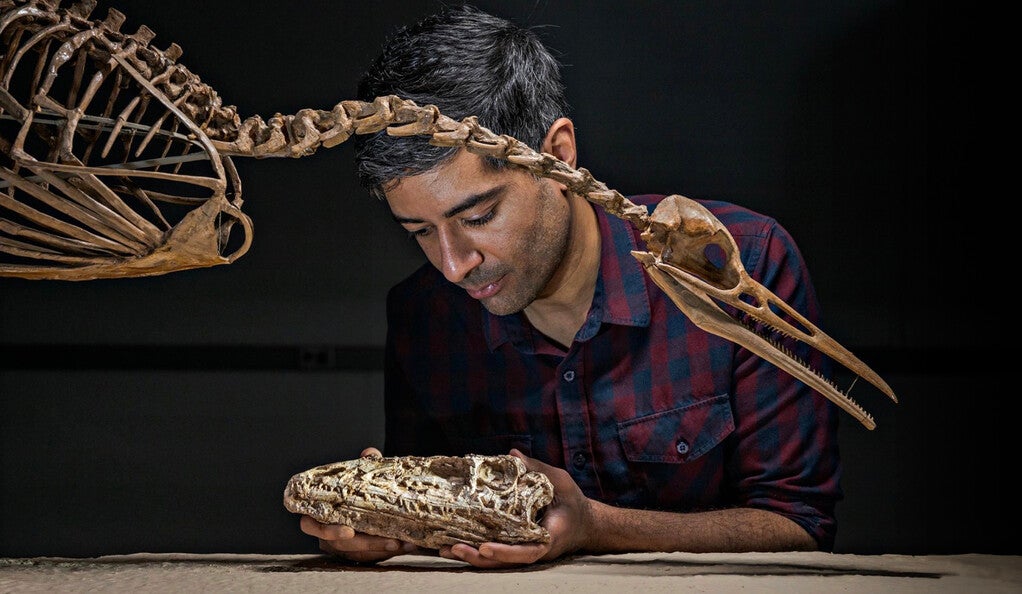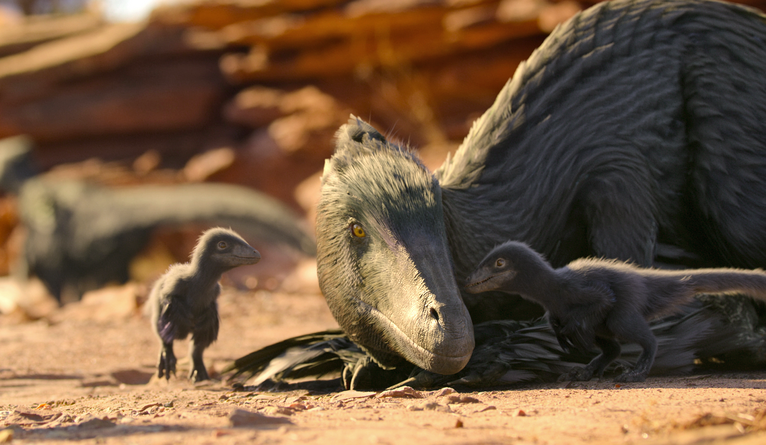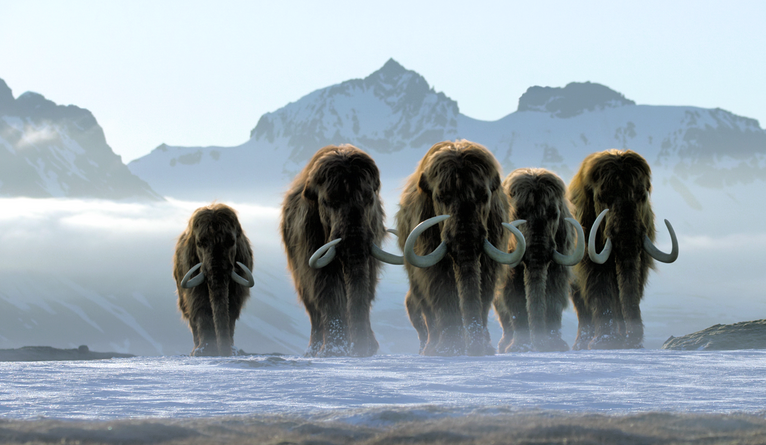The invisible threads that stitched together ‘Life on Our Planet’

Bhart-Anjan Bhullar (Photo courtesy of National Geographic)
“Life on Our Planet,” a new Netflix documentary series co-produced by Steven Spielberg, bears a hefty amount of Yale science DNA.
Not only does it feature the feathered dinosaur Deinonychus, identified by Yale paleontologist John Ostrom in the 1960s, and credit Yale expertise in every episode — it also shares an organizing principal with Yale.
Like the popular Yale paleontology course “History of Life,” the new documentary series tells the story of life on Earth as a tale of competing dynasties that vie for dominance amid a series of cataclysmic extinction events that periodically reset the playing field.

We recently caught up with Yale paleontologist Bhart-Anjan Bhullar, who was one of the main scientific consultants for “Life on Our Planet,” which premieres Oct. 25. Bhullar is an associate professor of Earth and planetary sciences in Yale’s Faculty of Arts and Sciences and an associate curator at the Yale Peabody Museum.
The Peabody and Netflix partnered for an advanced screening of an episode of the documentary series on Oct. 19.
What approach does this series take in telling the story of how life developed?
Bhart-Anjan Bhullar: It doesn’t have an agenda. The production team’s ambition was to take the history of life on Earth, and humanity’s place in it, and make a clear narrative about this most fundamental of stories. It’s an attempt to inspire a sense of wonder about the enormous good fortune that attends humanity’s very existence.
Actually, it’s much the same story we’ve already been telling at Yale for years, in the “History of Life” course that Derek Briggs [the G. Evelyn Hutchinson Professor of Earth and Planetary Sciences], Pincelli Hull [associate professor of Earth and planetary sciences], and I have been teaching for almost a decade. I even sent the producers the text from my lectures for that class.

Let’s delve more into this notion of competing empires over millions of years. Can you give me an example of a key moment in this story?
Bhullar: The best way to think of it is a roiling series of catastrophes and windfalls, then more catastrophes and windfalls, each one leading to the rise or fall of rival dynasties. There is a knife’s edge aspect to it, a series of moments in which, had things gone just a bit differently, the world would be unrecognizable. This owes in part to the overwhelming force of certain events. After each great extinction event, there is a scramble for supremacy among the survivors.
For instance, after the [Permian-Triassic] extinction event 250 million years ago, the dice were re-rolled. Most of the proto-mammals, which had been dominant, were wiped out. The big winners when the dust cleared were reptiles, and their dominion eventually led to the “Age of Dinosaurs.” Dinosaurs would have continued being dominant, to this day, if it weren’t for an asteroid that hit the Earth 66 million years ago.
The whole world burned. And then, once again, there was a mad scramble for the throne. During that next 10 million years, mammals won out. By a thread.

How did you get involved in the documentary?
Bhullar: Back in 2019, Jakob Vinther, a former Yale doctoral student who is now at the University of Bristol in the UK, contacted me and Derek to gauge interest in advising on the scientific accuracy of the production. Jakob connected us with Silverback Films and Dan Tapster, the series producer for the project.
Everyone from Silverback was wonderful – the writers and directors. We had lots of Zoom calls, going from concepts and language to settings for telling the story.
Special effects are obviously a big part of a series like this. What can you tell us about that?
Bhullar: Industrial Light & Magic did the effects. I spent time at the ILM offices in London, and at the Silverback Film offices in Bristol, where I helped the filmmakers refine the 3D models of the animals. We made supremely accurate dinosaurs, working from the inside to the outside. I can tell you that even the unseen skeletons of these CGI animals are more accurate than anything that’s come before.
At one point, they took us to a theater and brought in teams of animators — the “muscle” team, the “feather” team — it was incredible. It’s one of the best things of which I’ve ever been a part. They had a clear vision and they married it to beautiful prose and beautiful effects.
And to top it all off, there’s narration from the great Morgan Freeman, yes?
Bhullar: Absolutely. What a perfect voice to convey the scale we wanted to achieve.
Do you have a favorite moment from the finished product?
Bhullar: There are several, but one that comes to mind is an ocean scene that shows a great swirl of fish, surrounded by sharks and dolphins, with birds diving in from above. And the point being made is that this incredible mosaic of creatures is the result of millions of years of independent evolution, all brought together because their individual dynasties adapted to everything the planet and the cosmos have thrown at them.
And yet they all have a common ancestor. Every life on Earth is connected to the past by invisible threads — it’s almost a spiritual connectivity that one can feel, the history written within us and surrounding us. The story of how we came to exist is, I think, the greatest story there is.
Media Contact
Michael Greenwood: michael.greenwood@yale.edu, 203-737-5151